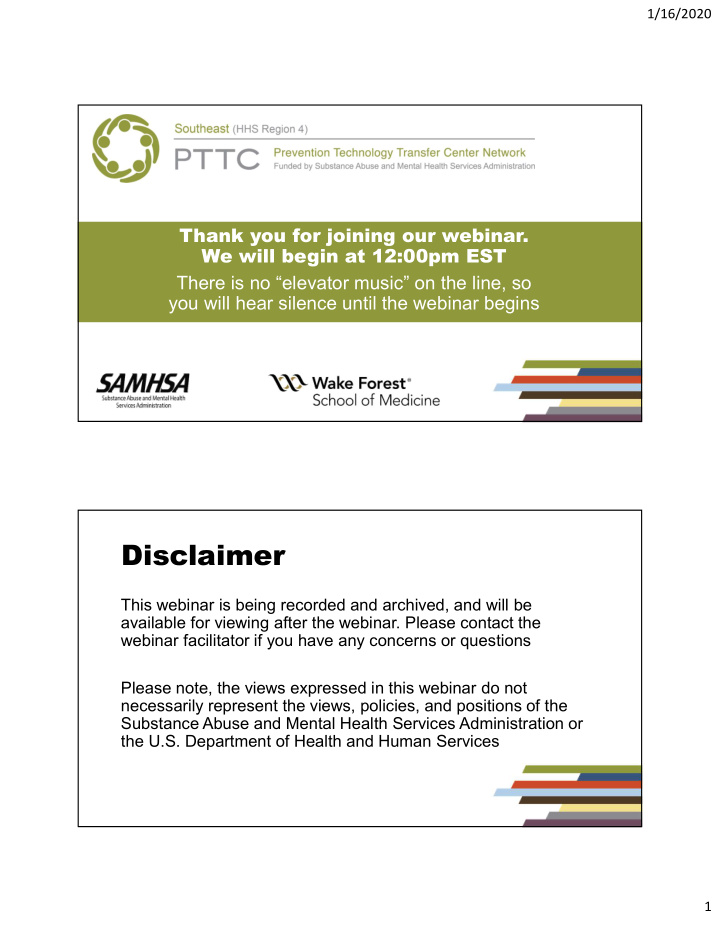



1/16/2020 Thank you for joining our webinar. We will begin at 12:00pm EST There is no “elevator music” on the line, so you will hear silence until the webinar begins Disclaimer This webinar is being recorded and archived, and will be available for viewing after the webinar. Please contact the webinar facilitator if you have any concerns or questions Please note, the views expressed in this webinar do not necessarily represent the views, policies, and positions of the Substance Abuse and Mental Health Services Administration or the U.S. Department of Health and Human Services 1
1/16/2020 Post Webinar Evaluation: SAMHSA’s GPRA Participation in our evaluation lets SAMHSA know: • # attended • How satisfied • How useful All responses are confidential and not linked to you. Certificate of attendance (pdf to be customized by you) 2
1/16/2020 Interacting with us on the webinar Interacting with us on the webinar Click Q&A 3
1/16/2020 Interacting with us on the webinar Click Q&A Agenda • Setting the stage & introduction of presenter(s) • The presentation • Q&A • Announcements/Evaluation 4
1/16/2020 Setting the Stage Mark Wolfson, PhD Director, SE PTTC Guest Presenters Innovative Strategies for Engaging Underserved Populations Wanda Boone, PhD Teresa Bishop 5
1/16/2020 Underserved Populations: Underserved, vulnerable and Examples: special needs communities • Ethnic/Cultural Minorities include: • Immigrant populations • members of minority • Low income or homeless populations individuals • individuals who have • Chronically ill or disabled experienced healthcare disparities • Certain geographical communities • LGBTQ+ population - Department of Health and Human Services • Very young or very old Poll Question #1 6
1/16/2020 Community Disengagement A World View A Community View An Individual View 7
1/16/2020 The World as a Village of 100 • 57 would be Asian, • 21 would be European • 14 would be North and South American, • 8 would be African • 70 of the 100 would be non-white (30 would be white) • 70 of the 100 would be non-Christian • 50 % of the wealth would be in the hands of 6 and all 6 would live in the US. • 80 would live in sub-standard housing • Only 1 would have a college education Poll Question #2 8
1/16/2020 Historical Trauma • An event, set events, that happen to a group of people who share a specific identity. That identity could be based in nationality, tribal affiliation, ethnicity, race and/or religious affiliation. • Each individual event is profoundly traumatic and when you look at events as a whole, they represent a history of sustained cultural disruption and community destruction. Health Disparities 9
1/16/2020 WHAT DO I SEE? When inequities are high: When inequities are low: Adverse Living Conditions, Good Living Conditions, Poor Performing Schools, Quality Schools, Poverty Access to Healthy Foods, Jobs 10
1/16/2020 “ If you want to improve in major ways, change your frame of reference. Change how you see the world, how you think about people…Change your paradigm, your scheme for understanding and explaining certain aspects of reality. ” Stephen R. Covey Principle-Centered Leadership • AGE • RACE • SEXUALITY • SKIN TONE • GENDER • ABILITY • CLASS • RELIGION • ETHNICITY Catch Up Already! 11
1/16/2020 The Strategies to Empower and Engage Underserved Populations Table Advocacy Voice Relationship 12
1/16/2020 Caring Equality Our differences, our Social Justice history, implicit bias Integrity, Honesty and real our personal Responsibility life experiences are Restraint keeping us apart. Being apart makes everything harder. We need each other. Small “p” Policy Change 13
1/16/2020 UBUNTU Be intentional - identify and acknowledge Partner with other organization serving the target groups Preparation Identify and build relationships with informal and formal leaders and strategies Assess the characteristics of the target group to serve the underserved Assess organizational capacity Create a plan to engage and empower Be patient 14
1/16/2020 Be intentional: Identify and Acknowledge Use data to identify and acknowledge gaps in service delivery: • Geographic • Demographic • Developmental Partnerships are key! Network and build partnerships with: • Others who are successfully serving the target population (i.e. health department, community/faith-based organizations) • Grassroot leaders, activists and/or allies from or have credible relationships with the target populations 15
1/16/2020 Assess the Characteristics Utilize social determinants of health to pinpoint and underserved populations: • Neighborhood and environment • Social and community context • Economic Stability • Healthcare • Education • Staff recruitment and composition • Training • Implicit Bias • Trauma Informed Care • Special Populations • Accountability and Outreach • Team synergy and problem solving Assess/strengthen • Culturally appropriate organizational capacity publications/materials 16
1/16/2020 Engaging and Empowering the Underserved • Create the space for engagement • Support Community-led efforts Engaging and Empowering the Underserved Create opportunities for the underserved to be heard: • Community Conversations • Focus Groups • One-on-ones 17
1/16/2020 Our Community Engagement • Training Model: • Organizational Support Lincoln Park Advisory Committee • Recognition (LPAC) Be Patient 18
1/16/2020 Q&A Mark Your Calendar – pttcnetwork.org/southeast Friday, Jan 31 @ 12:30 pm ET Youth Opioid Addiction: What Preventionists Need to Know Wednesday, Feb 5 @ 12:30 pm ET Best Practices for Prevention Media Campaigns 19
1/16/2020 How to Contact Us T: 336-713-1137 southeast@pttcnetwork.org facebook.com/PTTCSoutheast @PTTCSoutheast pttcnetwork.org/southeast 20
Recommend
More recommend